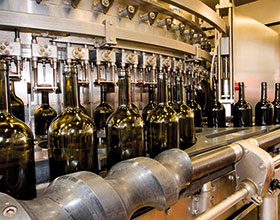

Why would someone want a cable that acts like an antenna? After all, much research and development has gone into improving cable shields precisely to prevent this! As it turns out, there are several conditions in industrial communication systems where using a radiating cable as an antenna offers major benefits. The most common cases are for communicating to equipment moving along a track, replacing slip rings in rotating equipment, and providing a clear RF signal where obstructions or plant-floor layout prevent a clear line-of-sight to transmit from a traditional antenna.
What is a radiating cable?
A radiating cable is a long, flexible antenna with slots to radiate RF signals. It can be installed around corners, along monorail systems and through tunnels to propagate wireless data signals in situations that are tough or impossible for traditional antennas. Since the radiating cable antenna can be mounted within inches of where the signal needs to be received, it isolates the wireless signal from going to other machines that may be on the plant floor.
In a typical coaxial cable, a metallic shield wrapped around the cable isolates the signals transmitted on the cable from the electromagnetic waves in the air around it. This helps to maintain a strong signal on the cable, and prevents that signal from creating interference with radio frequency (RF) equipment nearby. Without the shield, the cable would act like an antenna, transmitting the signal it carries into the air, and receiving radio waves from other RF devices. For those who remember analog cable TV, we experienced this phenomenon when we saw ‘ghost’ images on certain channels. Instead of just receiving the video signal sent from the cable company along the coaxial cable, we were also receiving that channel’s over-the-air broadcast of the same video signal as picked up by the coaxial cable working like an antenna. This was an unintentional use of radiating cable, and produced undesirable results.
The same principle that gave us blurry television pictures back then is used to make a cable that intentionally radiates signals. This is called a radiating cable, or leaky feeder. The difference between radiating cable and poorly shielded TV cables is that the shield on a radiating cable is designed with exacting slots that allow for the transmission of signals at a specific frequency. In this way, these cables are tuned to the RF equipment to which they are connected. The cable’s shield still works to block unwanted RF, but will allow signals of the correct frequency to emit from, and be received by, the cable inside. That makes a radiating cable act just like an antenna.
Placing RF signals precisely in crowded plants
Another benefit of using radiating cables comes from the ability to place RF power very precisely. The use of wireless communication equipment in factories is growing rapidly, which means that factory floors are becoming crowded with radio waves on all the common frequencies. For machine builders who need to use wireless, this creates a real problem. With a radiating cable solution, new machines can co-exist within the crowded plant RF space without adding to the cacophony. This is because radiating cable emits RF in one direction, and only needs as much power as it takes to link with another antenna at a relatively fixed distance. While the plant’s general Wi-Fi network is screaming to everyone who will listen, the equipment on the new machine can operate at a whisper.
This benefit is especially important in rotating machinery that traditionally used slip rings to conduct communication signals from I/O on the moving part of the machine to a controller on the fixed part. Slip rings are expensive to install, require regular maintenance, and even still suffer from poor communication speeds due to noise on the rings and in the pick-ups that ride on the rings. Traditional wireless solutions can work, but often the motion of the machine will obstruct the wireless link, requiring higher gain antennas that result in greater RF noise pollution. Radiating cable is used in these applications to provide a clear, consistent path to the rotating antenna, without interfering with other nearby wireless systems.
Flexibility
Radiating cable also benefits from its inherent flexibility. Since it is a cable, it can follow almost any path to provide wireless signal in places where antennas can just reach. One of the early applications for radiating cable was to enable two-way radio connectivity for emergency workers inside highway and rail tunnels. In the industrial setting, there are many hard-to-reach places, whether those are actual tunnels or ‘RF tunnels’ created by obstructions. An example of that would be a warehouse, where the metal racks and merchandise can cause obstruction and reflection issues for a traditional antenna. Radiating cable on the other hand can be installed along the aisles to provide a strong signal just where it is needed.
Summary
For certain industrial communication challenges, radiating cable offers unique advantages. It provides consistent data rates over a long distance, can be shaped to provide signal in difficult-to-reach environments, and reduces plant RF congestion by constraining its RF signal to the exact area where it is needed. These benefits are especially valuable in applications where machines move along a pre-defined path, where the terrain of a facility is particularly difficult to reach with broad coverage, and where signals on rotating equipment are otherwise transmitted through slip rings. Care must be taken in selecting and installing the components of a radiating cable solution. However, with a bit of preparation and advice from an experienced industrial RF vendor, a radiating cable system can provide trouble-free communications for the toughest applications.
For more information contact Bob Petrie, Throughput Technologies, +27 (0)11 705 2497, [email protected], www.throughput.co.za
| Tel: | +27 11 705 2497 |
| Email: | [email protected] |
| www: | www.throughput.co.za |
| Articles: | More information and articles about Throughput Technologies |

© Technews Publishing (Pty) Ltd | All Rights Reserved